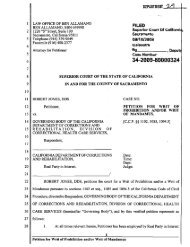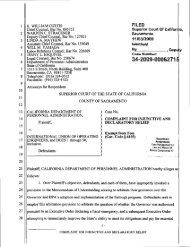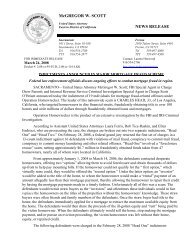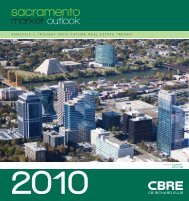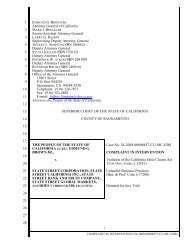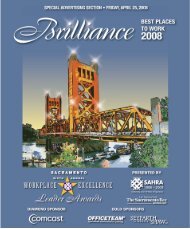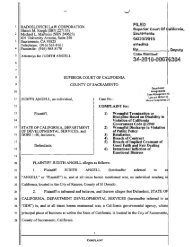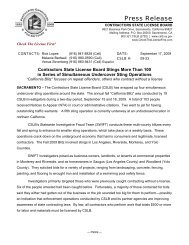Plan for the Closure of Lanterman Developmental Center
Plan for the Closure of Lanterman Developmental Center
Plan for the Closure of Lanterman Developmental Center
You also want an ePaper? Increase the reach of your titles
YUMPU automatically turns print PDFs into web optimized ePapers that Google loves.
uilding, an audiology building, was constructed in 2006 with funds from <strong>the</strong> Alameda<br />
Corridor East (ACE) high-speed railroad project. The ACE project added two new<br />
tracks to <strong>the</strong> existing Union Pacific Railroad line that travels through <strong>the</strong> <strong>Lanterman</strong><br />
campus. Constructing <strong>the</strong> new building was necessary as a mitigation measure, since<br />
<strong>the</strong> existing audiology building was located in close proximity to <strong>the</strong> railroad tracks and<br />
was negatively impacted by <strong>the</strong> increased noise and vibration from <strong>the</strong> expanded line.<br />
In keeping with changes in <strong>the</strong> evolution <strong>of</strong> pr<strong>of</strong>essional thinking and public perceptions<br />
concerning <strong>the</strong> care and treatment <strong>of</strong> persons with developmental disabilities, <strong>the</strong> name<br />
<strong>of</strong> <strong>the</strong> facility was changed several times over <strong>the</strong> years. In 1953, <strong>the</strong> facility became<br />
known as Pacific State Hospital; in 1979 it was re-named <strong>Lanterman</strong> State Hospital, in<br />
honor <strong>of</strong> Assembly Member Frank D. <strong>Lanterman</strong>; and finally, in 1985, it became known<br />
as <strong>the</strong> <strong>Lanterman</strong> <strong>Developmental</strong> <strong>Center</strong>. At its peak population in 1962, <strong>Lanterman</strong>’s<br />
census was 3,058 residents.<br />
CURRENT PROPERTY DESCRIPTION<br />
The <strong>Lanterman</strong> campus is an assemblage <strong>of</strong> properties acquired as early as 1919<br />
through various transactions, including sale, purchase and condemnation. The<br />
Department <strong>of</strong> General Services (DGS) has in<strong>for</strong>med DDS that a review by DGS <strong>of</strong><br />
existing documents indicates <strong>the</strong>re are no deed restrictions. However, due to <strong>the</strong><br />
antiquity <strong>of</strong> <strong>the</strong> transfers, DGS believes an additional review <strong>of</strong> <strong>the</strong> archived documents,<br />
chain <strong>of</strong> title, preliminary title report, and court reports will be necessary to completely<br />
establish <strong>the</strong> State’s unrestricted title to <strong>Lanterman</strong>.<br />
The current campus is located in eastern Los Angeles County on <strong>the</strong> western end <strong>of</strong> <strong>the</strong><br />
City <strong>of</strong> Pomona. It is also adjacent to <strong>the</strong> City <strong>of</strong> Diamond Bar on <strong>the</strong> east and south.<br />
The boundaries <strong>of</strong> <strong>the</strong> cities <strong>of</strong> Walnut and Industry are nearby to <strong>the</strong> west and<br />
southwest. The campuses <strong>of</strong> Cali<strong>for</strong>nia State Polytechnic University Pomona and<br />
Mt. San Antonio College in Walnut are also located nearby to <strong>the</strong> northwest and west.<br />
Three freeways are in <strong>the</strong> immediate vicinity: State Routes 57 and 60, and Interstate 10.<br />
In 1971, <strong>the</strong>re was a transfer <strong>of</strong> approximately 160 acres to Cali<strong>for</strong>nia State Polytechnic<br />
University Pomona. The property today is comprised <strong>of</strong> three separate parcels <strong>of</strong><br />
128.83 acres, 141.66 acres, and 16.14 acres, <strong>for</strong> a total <strong>of</strong> 286.63 acres. The Union<br />
Pacific Railroad tracks and <strong>the</strong> South San Jose Storm Drain Channel parallel to it cross<br />
<strong>the</strong> property. Most <strong>of</strong> <strong>the</strong> campus, 271 acres, is on <strong>the</strong> east side <strong>of</strong> <strong>the</strong> railroad tracks,<br />
with just 16 acres located on <strong>the</strong> west side <strong>of</strong> <strong>the</strong> tracks leading to Pomona Boulevard.<br />
The property has two points <strong>of</strong> access with <strong>the</strong> main entrance via <strong>the</strong> State<br />
Street/Highland Valley Road bridge overpass over <strong>the</strong> 57 Freeway to/from North<br />
Diamond Bar Boulevard to <strong>the</strong> east, and a secondary entrance <strong>of</strong>f West Pomona<br />
Boulevard to <strong>the</strong> west. The campus is somewhat locked in with limited access due to<br />
<strong>the</strong> railroad tracks, storm drain channel, surrounding agricultural land and housing and<br />
commercial developments, steep terrain, and limited frontage on Pomona Boulevard.<br />
25





